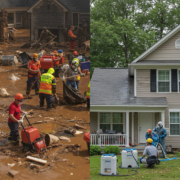Flood Cleanup in Dayton OH vs. Water Damage Restoration: What’s the Difference?
When water invades your Dayton home, understanding the nature of the problem is the first step toward effective resolution. Many homeowners use the terms “flood cleanup” and “water damage restoration” interchangeably, but professionals in the field recognize crucial distinctions that significantly impact the approach, cost, and timeline of recovery. Understanding these differences can help Dayton residents make informed decisions when facing water-related emergencies.
Understanding Water Damage Restoration in Dayton
Water damage restoration addresses water issues originating from within your home. This comprehensive process involves returning your property to its pre-damage condition through systematic procedures.
Common sources include:
- Burst pipes or plumbing failures
- Appliance malfunctions (water heaters, washing machines)
- Roof leaks during heavy rainfall
- HVAC system issues
- Overflowing bathtubs or sinks
The restoration process typically begins with water extraction using powerful pumps and vacuum units. technicians then focus on drying through industrial-grade air movers and dehumidifiers. Cleaning and sanitizing follow, with particular attention to preventing mold growth. The final phase involves repairs and restoration, which may include replacing drywall, flooring, or other damaged materials.
Professional water damage restoration in Dayton employs specialized moisture detection equipment to identify hidden moisture pockets, ensuring complete drying and preventing future mold issues.
The Specifics of Flood Cleanup in Dayton OH
Flood cleanup addresses water intrusion originating from outside the home. This distinction is critical because floodwaters typically contain contaminants that pose health risks and require specialized handling.
Typical flood scenarios in Dayton include:
- River overflows from the Great Miami River or nearby waterways
- Surface flooding from heavy storm systems
- Ground saturation leading to basement seepage
- Storm surge-related flooding
Flood cleanup involves unique challenges beyond standard water damage restoration. The water category is typically Class 3 or “black water,” containing harmful contaminants from sewage, chemicals, and outdoor debris. This requires advanced safety protocols, including protective equipment and specialized cleaning agents.
The process begins with extensive documentation for insurance purposes, as flood damage often requires separate insurance policies. cleanup teams prioritize removing hazardous materials and contaminants before beginning the water extraction process. Structural safety assessments are crucial, as floodwaters can compromise building foundations.
Key Differences Dayton Homeowners Should Recognize
1. Water Source and Contamination Level
The most significant difference lies in the water’s origin and contamination level. Internal water damage typically involves cleaner water, while flood cleanup deals with contaminated water requiring hazardous material protocols.
2. Insurance Coverage Variations
Most standard homeowners insurance policies cover water damage restoration but specifically exclude flood cleanup. Dayton homeowners typically need separate flood insurance through the National Flood Insurance Program for flood-related incidents.
3. Safety Protocols and Equipment
Flood cleanup requires more extensive safety measures, including protective gear, antimicrobial treatments, and sometimes temporary structural supports. Restoration technicians handling flood scenarios receive additional certification for hazardous environments.
4. Drying and Sanitization Approaches
While both processes involve drying, flood cleanup requires more intensive sanitization. Affected materials like drywall and insulation often require complete removal rather than restoration due to contamination levels.
5. Timeline and Complexity
Flood cleanup generally takes longer and involves more complex procedures. The extensive contamination assessment and sanitization requirements add significant time compared to standard restoration projects.
Why the Distinction Matters for Dayton Residents
Understanding this difference is crucial when contacting service providers. When calling for assistance, accurately describing your situation helps companies dispatch the appropriately trained team and equipment. For instance, mentioning “basement flooding from the recent storm” versus “water heater leak” ensures you receive technicians qualified for the specific challenge.
The geographical reality of Dayton, with its proximity to the Great Miami River and susceptibility to severe weather patterns, means many residents will eventually face water-related challenges. Recognizing whether you’re dealing with internal water damage or external flooding helps set realistic expectations for timeline, cost, and the scope of work required.
Choosing the Right Service Provider
Whether facing flood cleanup or water damage restoration, Dayton homeowners should verify that service providers have:
- IICRC certification with specific credentials for both restoration and flood cleanup
- Proper insurance and licensing for hazardous material handling when needed
- Local experience with Dayton’s specific water challenges
- Clear communication about which type of service your situation requires
Conclusion: Knowledge Leads to Better Outcomes
When water affects your Dayton home, recognizing the distinction between flood cleanup and water damage restoration empowers you to seek the appropriate help, understand the necessary procedures, and navigate insurance requirements more effectively. While both services aim to restore your property, their approaches differ significantly based on the water source, contamination level, and associated risks. By understanding these differences, you can make informed decisions that lead to safer, more efficient recovery when facing water-related emergencies in the Miami Valley region.

